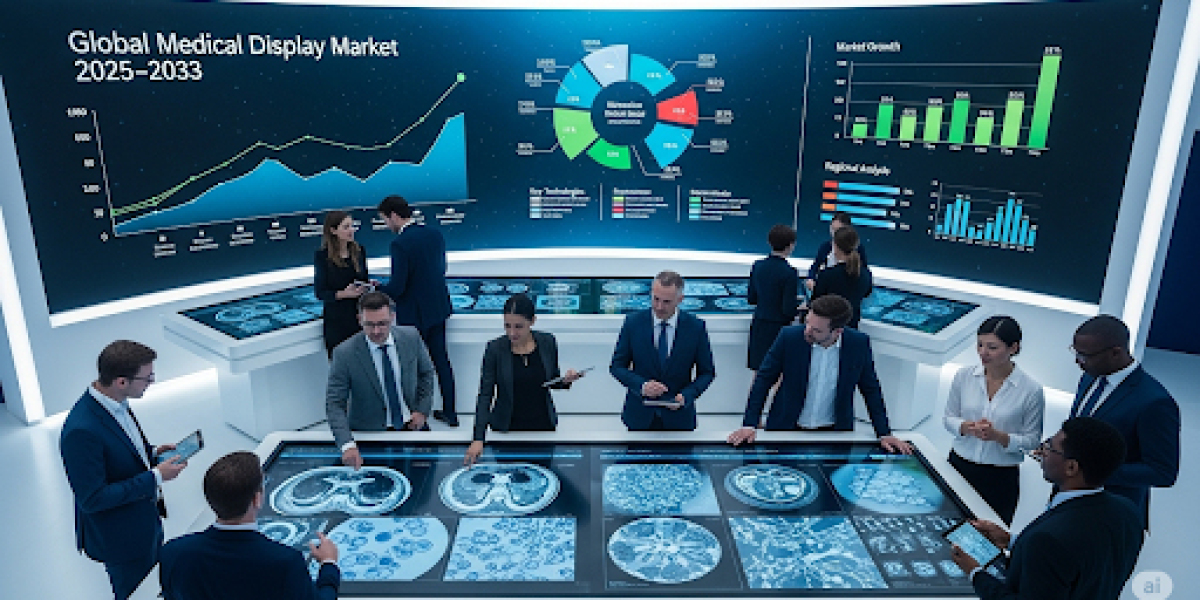MARKET OVERVIEW
The global medical display market hit USD 2.81 billion in 2024 and is expected to grow to USD 4.41 billion by 2033, with a compound annual growth rate (CAGR) of 4.88%. This growth is driven by the rapid rise of telemedicine and teleradiology, advancements in medical imaging technology, increasing rates of chronic diseases, an aging population, and stricter regulatory standards that ensure diagnostic accuracy.
STUDY ASSUMPTION YEARS
- BASE YEAR: 2024
- HISTORICAL YEAR: 2019–2024
- FORECAST YEAR: 2025–2033
MEDICAL DISPLAY MARKET KEY TAKEAWAYS
- Asia‑Pacific held the largest share at 33.8 % in 2024, highlighting strong regional dominance.
- The market is expected to reach USD 4.41 billion by 2033, growing at 4.88 % CAGR from 2025–2033.
- Telemedicine and teleradiology expansion is a primary growth driver.
- Technological advancements—like 4K/8K, OLED monitors, and high‑resolution imaging—are accelerating adoption.
- Rising chronic disease prevalence and an aging population are increasing demand.
- Stringent regulatory compliance and quality standards in imaging devices are promoting investments.
MARKET GROWTH FACTORS
Rising Focus on Patient Safety & Accuracy
Patient safety is a top priority in modern healthcare, and medical displays play a key role in ensuring accurate diagnosis and treatment. Even the slightest misinterpretation of medical images can lead to errors, which may compromise patient outcomes. High-performance medical displays minimize these risks by providing precise, distortion-free visuals that help doctors detect conditions early. Regulatory bodies like the FDA and European health agencies also emphasize accuracy in medical imaging, pushing hospitals to adopt certified medical-grade displays. Furthermore, displays with consistent brightness and color calibration reduce eye strain for doctors, allowing them to work efficiently for long hours. As healthcare systems strive to minimize errors and improve patient safety, the demand for reliable medical displays is expected to rise further. This focus on safety not only benefits patients but also builds trust in medical institutions, making it a strong driver for market growth.
Technological Innovations in Display Design
The medical display industry itself is experiencing remarkable innovation, which is fueling market growth. Manufacturers are developing displays with higher luminance, anti-reflective coatings, improved contrast ratios, and longer lifespans to meet the evolving needs of healthcare professionals. Some companies are even exploring OLED and 8K technologies for sharper and more reliable medical imaging. Portable medical displays and wireless connectivity are also emerging, making it easier for doctors to access imaging data anywhere in a hospital. These innovations not only enhance diagnostic accuracy but also improve the overall efficiency of healthcare systems. As competition grows, manufacturers are focused on delivering cost-effective yet advanced solutions, making these displays more accessible to healthcare institutions worldwide. The continuous stream of innovations ensures that the medical display market will remain dynamic and attractive for both buyers and investors in the years ahead.
Increasing Investments in Healthcare Infrastructure
Governments and private healthcare providers are investing heavily in infrastructure development, which directly fuels the medical display market. New hospitals, diagnostic centers, and specialty clinics are being equipped with state-of-the-art technology, and medical displays are an essential part of these upgrades. Emerging economies in Asia, Latin America, and the Middle East are especially focusing on strengthening their healthcare systems to meet rising patient demands. These regions are adopting advanced imaging solutions at a rapid pace, creating lucrative opportunities for display manufacturers. In developed markets, continuous renovations and technology updates are also driving adoption. From operating rooms to diagnostic imaging suites, displays are becoming central to healthcare modernization. The push for better patient care, combined with rising government spending, ensures that medical displays remain in high demand. This infrastructure-driven growth is setting the stage for long-term market expansion across both developed and developing economies.
Request for a sample copy of this report: https://www.imarcgroup.com/medical-display-market/requestsample
MARKET SEGMENTATION
By Device
- Desktop monitors
- Mobile monitors
- All‑in‑one product
By Panel Size
- Under 22.9‑inch panels
- 23.0–26.9‑inch panels
- 27.0–41.9‑inch panels
- Above 42‑inch panels
By Resolution
- Up to 2 MP resolution displays
- 2.1–4 MP resolution displays
- 4.1–8 MP resolution displays
- Above 8 MP resolution displays
By Technology
- CCFL‑backlit LCD display
- LED‑backlit LCD display
- OLED display
By Application
- Diagnostic applications (including multi‑modality, mammography, general radiology, digital pathology)
- Surgical/interventional applications
- Dentistry applications
- Other applications
By End User
- Hospitals
- Diagnostic centres
- Community healthcare
Breakup by Region
- North America (United States, Canada)
- Asia Pacific (China, Japan, India, South Korea, Australia, Indonesia, Others)
- Europe (Germany, France, United Kingdom, Italy, Spain, Russia, Others)
- Latin America (Brazil, Mexico, Others)
- Middle East and Africa
REGIONAL INSIGHTS
The Asia Pacific region is set to dominate the global medical display market in 2024, holding a significant 33.8% share. This growth is fueled by the expansion of telemedicine infrastructure, the increasing burden of chronic diseases, and healthcare modernization efforts in countries like China, Japan, India, and South Korea. Additionally, hospitals and diagnostic labs are embracing high-resolution imaging technologies more than ever.
RECENT DEVELOPMENTS & NEWS
Recently, we've seen major vendors rolling out 4K medical displays aimed at improving clarity in surgical imaging and remote diagnostics. The latest advancements focus on ultra-high-definition panels for procedures such as interventional radiology and digital pathology, along with displays designed to meet medical-grade standards, including compatibility with PACS. These innovations are not only enhancing precision in diagnostics but also encouraging a greater global adoption of telemedicine.
KEY PLAYERS
- B. Braun Melsungen AG
- Bracco N.V
- Conmed Corporation
- Eizo Corporation
- Karl Storz SE & Co. KG
- LG Corporation
- Medtronic PLC
- Olympus Corporation
- Sony Corporation
- Steris plc
- Stryker Corporation
Ask Analyst for Customization: https://www.imarcgroup.com/request?type=report&id=5475&flag=C
If you require any specific information that is not covered currently within the scope of the report, we will provide the same as a part of the customization.
About Us:
IMARC Group is a global management consulting firm that helps the world’s most ambitious changemakers to create a lasting impact. The company provides a comprehensive suite of market entry and expansion services. IMARC offerings include a thorough market assessment, feasibility studies, company incorporation assistance, factory setup support, regulatory approvals and licensing navigation, branding, marketing and sales strategies, competitive landscape, and benchmarking analyses, pricing and cost research, and procurement research.
Contact Us:
IMARC Group
134 N 4th St. Brooklyn, NY 11249, USA
Email: sales@imarcgroup.com
Tel No: (+1-201971-6302)
















